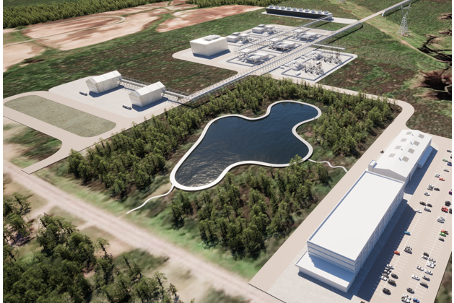(Shawinigan) How many and where? This is what some Mauricie elected officials concerned by TES Canada’s green hydrogen megaproject are wondering, which is counting on the construction of 140 wind turbines throughout the region to meet the energy needs of its complex. They give the runner a chance, but remind us that the ball is in the promoter’s court.
“For me, it’s a great project, with a big question,” says the mayor of Saint-Maurice, Gérard Bruneau, in an interview Friday in Shawinigan, on the sidelines of the confirmation of the project. This is unknown to many people. »
This municipality of approximately 3,700 residents is one of the locations identified by TES Canada to implement the self-production portion of its project – an 800 megawatt (MW) wind farm combined with a 200 MW solar park. This is in addition to the 150 MW block – the equivalent of approximately 30 times the power of the Bell Center – obtained by the company from Hydro-Québec.
The theme of social acceptability quickly emerged at the press conference aimed at confirming the details of the 4 billion project – already revealed by La Presse. A sign of the openness of local elected officials, they were present at the event, which was also attended by the Minister of the Economy, Innovation and Energy, Pierre Fitzgibbon, and the Federal Minister of Innovation, Sciences and Industry, François-Philippe Champagne.
Some politicians nevertheless have questions and refuse to be the only ones to convince citizens. The appearance of more than a hundred wind turbines within a radius of around thirty kilometers from Shawinigan – where the company’s hydrogen electrolyzer is to be installed – will change the landscape. TES Canada and its director Éric Gauthier will have to prove that the game is worth it if we say yes to the installation of wind turbines on its land, says Mr. Bruneau.
“People shouldn’t feel cheated by this,” he said. People must see it as an advantage and compensation. »
Green hydrogen – which requires a lot of energy – is considered an alternative solution in heavy industry (aluminum and steel mills), still dependent on fossil natural gas. The TES Canada complex will be divided into two facets: the production of green hydrogen and renewable synthetic natural gas. Énergir will be the main customer of the second component.
In Saint-Prosper-de-Champlain, where there are around 500 people, Mayor France Bédard says that her team welcomes private investment, which will be done without loans or subsidies, in Mauricie. Like her counterparts, the politician does not know, at this stage, where we would like to erect wind turbines or install photovoltaic panels.
“They [the promoters] have identified places and they are going to present them to us,” says Ms. Bédard. We will go with social acceptability. I think the project could be good for everyone. We also need to think about the future. »
Very enthusiastic, the mayor of Shawinigan, Michel Angers, pleads for an expansion of the notion of social acceptability. In his opinion, this concept must go beyond “not in my backyard”. Shawinigan should obtain the lion’s share of the investment – 2 billion – with the implementation of the hydrogen electrolyzer.
“Social acceptability also means participating in decarbonization,” said Mayor Angers, opening the curtain to the press conference. It’s thinking about our children and grandchildren. It also means changing our mentalities if we one day want to save the planet. »
TES Canada does not yet have all the answers to the questions of elected officials and concerned citizens. The company hopes to be able to reassure some during three public information sessions which are to take place in Shawinigan (November 21), Saint-Adelphe (November 27) and Saint-Narcisse (November 28).
Mr. Gauthier can already offer certain guarantees. The company he runs has already determined the places “where we cannot put” wind turbines.
“In wet areas, near roads, houses,” he summarizes. It won’t be in people’s backyards. It will be further away. It’s primordial. The next steps will be to inform the population. Depending on the receptivity, we will be able to identify the locations of the wind turbines. »
A subsidiary of the Belgian firm Tree Energy Solutions, TES Canada was co-founded by businesswoman France Chrétien Desmarais, daughter of former Prime Minister Jean Chrétien and wife of André Desmarais, deputy chairman of the board of Power Corporation of Canada . Ms. Chrétien Desmarais and the European company will act as funders of the project.
How did TES Canada choose Shawinigan? The Chrétien family’s roots in Mauricie weighed in the balance when Marcel Van Poecke and Paul Van Poecke, co-founders of Tree Energy Solutions, looked to North America.
“The Van Poecke brothers are friends,” said Ms. Chrétien Desmarais. It’s a bit of a combination of circumstances. When Canada arrived on their radar […] they approached us and there the project saw the light of day. »
The businesswoman conceded that there was a “little emotional side” that worked in Shawinigan’s favor, adding that all the elements, such as the available space, “were there.”
Currently, 95% of the world’s hydrogen is produced from fossil fuels. Hydrogen can be produced by electrolysis of water. This process involves passing an electric current through water. This allows its molecules to be broken down to then extract the hydrogen. We speak of green hydrogen when the current used comes from a renewable energy source, such as hydroelectricity.















